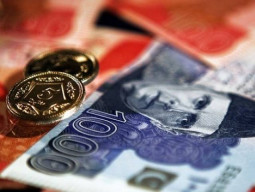
The government’s target is 5.7% against the real GDP growth of 4.7% in FY16.
Think tank calculates GDP growth at 3.1%
The central bank said in FY17 the fiscal deficit may remain in the range of 4-5% of GDP, which was well above the government’s target of 3.8%, according to the SBP’s Annual Report on the State of Economy for 2015-16, which was released on Thursday.
The government has envisaged a budget deficit of 3.8% for FY17 - 80 basis points (bps) lower than the actual deficit of 4.6% in 2015-16. This would require strong fiscal discipline and concerted efforts to enhance the revenues.
“The continuation of taxation reform for widening the tax base and bringing more people into the tax net will be the key to achieving the target,” the report stressed.
The central bank’s analysis gains more weightage when seen in light of the recent fiscal deficit figure for the first quarter (Jul-Sept) of FY17.
The fiscal deficit touched 1.3% of GDP in 1QFY17 - the highest in the last four years.
Analysts say the rise in fiscal deficit shows the government feels it has more elbow room after the recent conclusion of the IMF programme.
With an improved macroeconomic environment, better energy supplies and subsiding security concerns, business sentiments were upbeat, the report added.
In addition, a smooth progress on the China-Pakistan Economic Corridor (CPEC) related projects will ease infrastructure and energy constraints and also create demand for industrial output.
Economic activity would also benefit from pro-growth policies. The policy rate currently stands at a historic low of 5.75%, which has made funding easier for businesses and consumers.

How was the last year?
Commenting on the performance of economy in FY16, the report said the country’s economy maintained its momentum towards a higher growth trajectory in the year, as higher infrastructure spending by the government and decades-low interest rates provided a boost to domestic demand.
Economic Survey 2015-16: Off target, once again
“Some macroeconomic indicators were short of targets, but they still posted better performance over the previous year,” it said.
For instance, the real GDP growth of 4.7% during FY16 was below the target, but nevertheless higher than the growth achieved a year earlier.
Meanwhile, the accumulation of the country’s foreign exchange reserves reached an all-time high at the end FY16; the exchange rate remained stable; and the CPI inflation fell to only 2.9% during the year.
Similarly, fiscal consolidation remained on track and the budget deficit was reduced to 4.6% of GDP - the lowest since FY07.
Despite all these positives, the report highlights some challenges as well.
Firstly, the current level of private investments and savings in the country needed to be accelerated to keep pace with required investible resources.
Secondly, structural issues in the export industry needed to be resolved. Thirdly, the reliance of tax system on stop-gap measures was creating distortions in the economy. Finally, the country needed to spend more on social sector development to address social issues.
The report said the current account deficit was likely to stay in the range of 0.5-1.5% of GDP in FY17. In this context, it draws attention to the IMF programme’s contribution to restoring macroeconomic stability and confidence of international creditors.
Pakistan lagging behind other South Asian states
Crucially, it maintains that the reform process - related to the energy sector, loss-making PSEs (like PSM, PIA) and business-friendly regulations - must continue after the IMF programme’s completion.
The central bank reiterated that without private sector participation, it would be hard to achieve a higher and sustainable growth built on the pillars of entrepreneurship, innovation and competitiveness.
Published in The Express Tribune, November 18th, 2016.
Like Business on Facebook, follow @TribuneBiz on Twitter to stay informed and join in the conversation.

































1714024018-0/ModiLara-(1)1714024018-0-270x192.webp)









COMMENTS (1)
Comments are moderated and generally will be posted if they are on-topic and not abusive.
For more information, please see our Comments FAQ